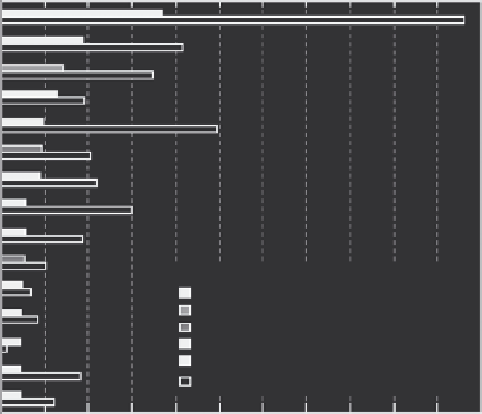Environmental Engineering Reference
In-Depth Information
Chloroform
Perchloroethene (PCE)
Methyl
tert
-butyl ether
(MTBE)
Trichloroethene (TCE)
Toluene
Dichlorodifluoromethane
(CFC-12)
1,1,1-Trichloroethane (TCA)
Chloromethane
Bromodichloromethane
Trichlorofluoromethane
(CFC-11)
Assessment level of 0.2 µg/L
Bromoform
Dibromochloromethane
Gasoline hydrocarbon
Gasoline oxygenate
Refrigerant
Solvent
Trihalomethane (THM)
trans
-1,2-Dichloroethene
(
trans
-1,2-DCE)
Methylene chloride
1,1-Dichloroethane
(1,1-DCA)
Assessment level of 0.02 µg/L
0
2
4
6
8
10
14
16
18
20
22
12
Detection frequency, in percent
FIGURE 8.20
Frequency of detection: most common VOCs. (From United States Geological Survey (USGS), Volatile organic
compounds in nation's ground water and drinking-water supply wells, National Water-Quality Assessment
Program, USGS Circular 1292, Washington, DC, 2006a.)
VOCs exist as light nonaqueous phase liquids (LNAPLs) and dense nonaqueous phase
liquids (DNAPLs). Because LNAPLs are lighter than water, they tend to float on top of
groundwater as depicted in Figure 8.8, whereas the heavier than water DNAPLs tend
to sink through the water column in an aquifer if conditions are favorable (Figure 8.21;
USGS 2006a).
Contaminant degradation rates vary widely and depend on many factors including (1)
the nature of the release, (2) physical chemistry of the contaminants themselves, (3) the
Well 1
FIGURE 8.21
Migration of DNAPL compounds. (From United States Geological Survey (USGS), Volatile organic compounds
in nation's ground water and drinking-water supply wells, National Water-Quality Assessment Program, USGS
Circular 1292, Washington, DC, 2006a.)



Search WWH ::

Custom Search